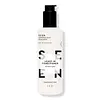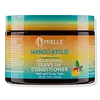What's inside
What's inside
 Key Ingredients
Key Ingredients

 Benefits
Benefits

 Concerns
Concerns

 Ingredients Side-by-side
Ingredients Side-by-side

Water
Skin ConditioningC13-15 Alkane
SolventCetearyl Alcohol
EmollientGlycerin
HumectantSqualane
EmollientBehentrimonium Chloride
PreservativeHydrolyzed Ceratonia Siliqua Seed Extract
Skin ConditioningMoringa Oleifera Seed Extract
Skin ConditioningBisabolol
MaskingZea Mays Starch
AbsorbentPolyquaternium-7
Guar Hydroxypropyltrimonium Chloride
Skin ConditioningTocopherol
AntioxidantDisodium EDTA
Ethylhexylglycerin
Skin ConditioningPotassium Sorbate
PreservativeDisodium Phosphate
BufferingSodium Benzoate
MaskingCitric Acid
BufferingPhenoxyethanol
PreservativeWater, C13-15 Alkane, Cetearyl Alcohol, Glycerin, Squalane, Behentrimonium Chloride, Hydrolyzed Ceratonia Siliqua Seed Extract, Moringa Oleifera Seed Extract, Bisabolol, Zea Mays Starch, Polyquaternium-7, Guar Hydroxypropyltrimonium Chloride, Tocopherol, Disodium EDTA, Ethylhexylglycerin, Potassium Sorbate, Disodium Phosphate, Sodium Benzoate, Citric Acid, Phenoxyethanol
Water
Skin ConditioningCetearyl Alcohol
EmollientPropylene Glycol
HumectantPolyquaternium-37
Propylene Glycol Dicaprylate/Dicaprate
EmollientPPG-1 Trideceth-6
Skin ConditioningBehentrimonium Chloride
PreservativePhenoxyethanol
PreservativeBenzoic Acid
MaskingEthylhexylglycerin
Skin ConditioningGlycereth-2 Cocoate
EmulsifyingDiheptyl Succinate
EmollientCapryloyl Glycerin/Sebacic Acid Copolymer
Skin ConditioningCocos Nucifera Oil
MaskingOcimum Americanum Leaf Oil
MaskingMangifera Indica Seed Butter
Skin ConditioningPanthenol
Skin ConditioningVitis Vinifera Seed Oil
EmollientAloe Barbadensis Leaf Juice
Skin ConditioningVaccinium Myrtillus Fruit/Leaf Extract
AstringentSaccharum Officinarum Extract
MoisturisingCitrus Aurantium Dulcis Fruit Extract
MaskingCitrus Limon Fruit Extract
MaskingAcer Saccharum Extract
Skin ConditioningOlea Europaea Fruit Oil
MaskingPrunus Amygdalus Dulcis Oil
Skin ConditioningButyrospermum Parkii Butter
Skin ConditioningLavandula Angustifolia Oil
MaskingSesamum Indicum Seed Oil
EmollientMelaleuca Alternifolia Leaf Oil
AntioxidantAminomethyl Propanol
BufferingParfum
MaskingWater, Cetearyl Alcohol, Propylene Glycol, Polyquaternium-37, Propylene Glycol Dicaprylate/Dicaprate, PPG-1 Trideceth-6, Behentrimonium Chloride, Phenoxyethanol, Benzoic Acid, Ethylhexylglycerin, Glycereth-2 Cocoate, Diheptyl Succinate, Capryloyl Glycerin/Sebacic Acid Copolymer, Cocos Nucifera Oil, Ocimum Americanum Leaf Oil, Mangifera Indica Seed Butter, Panthenol, Vitis Vinifera Seed Oil, Aloe Barbadensis Leaf Juice, Vaccinium Myrtillus Fruit/Leaf Extract, Saccharum Officinarum Extract, Citrus Aurantium Dulcis Fruit Extract, Citrus Limon Fruit Extract, Acer Saccharum Extract, Olea Europaea Fruit Oil, Prunus Amygdalus Dulcis Oil, Butyrospermum Parkii Butter, Lavandula Angustifolia Oil, Sesamum Indicum Seed Oil, Melaleuca Alternifolia Leaf Oil, Aminomethyl Propanol, Parfum
Ingredients Explained
These ingredients are found in both products.
Ingredients higher up in an ingredient list are typically present in a larger amount.
This ingredient is a preservative and often used for it's anti-static properties. You'll most likely see this ingredient in hair conditioners.
It does not cause irritation or sensitization in leave-on products at 1-5%.
Cetearyl alcohol is a mixture of two fatty alcohols: cetyl alcohol and stearyl alcohol. It is mainly used as an emulsifier. Emulsifiers help prevent the separation of oils and products. Due to its composition, it can also be used to thicken a product or help create foam.
Cetearyl alcohol is an emollient. Emollients help soothe and hydrate the skin by trapping moisture.
Studies show Cetearyl alcohol is non-toxic and non-irritating. The FDA allows products labeled "alcohol-free" to have fatty alcohols.
This ingredient is usually derived from plant oils such as palm, vegetable, or coconut oils. There is debate on whether this ingredient will cause acne.
Due to the fatty acid base, this ingredient may not be Malassezia folliculitis safe.
Learn more about Cetearyl AlcoholEthylhexylglycerin (we can't pronounce this either) is commonly used as a preservative and skin softener. It is derived from glyceryl.
You might see Ethylhexylglycerin often paired with other preservatives such as phenoxyethanol. Ethylhexylglycerin has been found to increase the effectiveness of these other preservatives.
Phenoxyethanol is a preservative that has germicide, antimicrobial, and aromatic properties. Studies show that phenoxyethanol can prevent microbial growth. By itself, it has a scent that is similar to that of a rose.
It's often used in formulations along with Caprylyl Glycol to preserve the shelf life of products.
Water. It's the most common cosmetic ingredient of all. You'll usually see it at the top of ingredient lists, meaning that it makes up the largest part of the product.
So why is it so popular? Water most often acts as a solvent - this means that it helps dissolve other ingredients into the formulation.
You'll also recognize water as that liquid we all need to stay alive. If you see this, drink a glass of water. Stay hydrated!
Learn more about Water